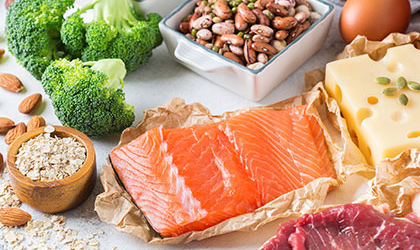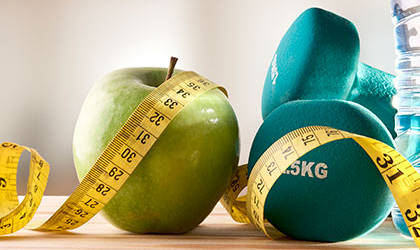
As a woman, you may notice that your ability and motivation to move changes throughout the month. One day, you may blitz through a 10km run and break your PB. On the other, you may struggle to coax yourself off the sofa. No – it doesn’t mean your fitness has gone out the window. There’s a simple explanation for that. And it all comes down to your hormones.
While the main role of the menstrual cycle is reproduction, the fluctuations in hormones also influence other physiological systems in the body. And, in recent years, there’s been a huge drive to understand how the menstrual cycle impacts physical performance, with elite athletes and coaches learning more about the effects.
Although this topic remains still woefully under-researched and certainly needs more high-quality data, what we’ve gathered so far can help women optimise their training results.
Here’s how to exercise in alignment with your menstrual cycle.
Menstrual cycle phases
Women have two predominant sex hormones: oestrogen and progesterone. Across a textbook 28-day cycle (although, it’s worth noting here that women aren’t ‘textbooks’; only 13 per cent of women have a 28-day cycle. A normal cycle is considered somewhere between 21 and 35 days, so don’t worry if your cycle is longer or shorter), these sex hormones ebb and flow.
You can learn more about the ‘seasons’ of your menstrual cycle here.
Menstrual phase (around days 1-7)
At the start of the cycle, oestrogen and progesterone fall, which causes the shedding of blood and the lining of your uterus. During this week, your energy is at its lowest. You may experience menstrual cramps, bloating, mood swings, tender breasts, headaches, and tiredness at this stage.
Exercise tips in the menstrual phase
Experiencing symptoms of menstruation doesn’t exactly ready you for exercise. But research suggests moderate-intensity activity, like yoga, may be a helpful tool to offset symptoms (1). Plus, around days 3-5, oestrogen starts to increase, so you may start to feel better and more inspired to move your body.
Consider: Light walking, Pilates or restorative yoga
Follicular phase (around days 6-11)
Following menstruation, oestrogen rises, leading to a surge in your energy and mood. This period is called the follicular phase as your pituitary gland releases a hormone called Follicle Stimulating Hormone (FSH), which causes the follicles (containing your eggs) in your ovaries to mature.
Exercise tips in the follicular phase
As oestrogen starts to rise in the latter stages of the follicular phase, you’ll want to capitalise on its energy-boosting properties and push your body. Oestrogen also has neuromuscular effects, increasing your ability to activate your muscles, so it’s an ideal time to schedule a few more high-intensity workouts.
However, some evidence suggests there’s an increased risk of injury in the late follicular phase since it can make tendons and ligaments laxer (2). This isn’t a reason to avoid exercise altogether; it’s just something to be aware of. It might be an idea to take more time to warm up at this stage.
Consider: Light running, hiking, swimming, or flow-based yoga
Ovulation phase (around days 12-19)
Oestrogen peaks during ovulation, while progesterone remains low. This is when you’ll be feeling (and looking) your best. Your energy levels will be at their highest, too.
Exercise tips in the ovulation phase
Although the spike in oestrogen can leave you more prone to injury, it can also increase your motivation to train. What’s more, oestrogen is believed to offer a protective function against muscle damage, which can help you recover quicker and adapt to training more readily (3). Aside from oestrogen, testosterone rises during ovulation, leading to a further surge in energy. Now’s the time to really push yourself.
Consider: A high-intensity workout, vigorous spin class, or heavy lifting
Luteal phase (around days 20-28)
After ovulation, oestrogen begins to drop off before it has a secondary peak around days 20 – 23. Progesterone also spikes at this time. Following this – if fertilisation hasn’t occurred – both hormones drop off and begin the cycle again.
As progesterone is a ‘calming’ hormone, you’ll notice yourself wanting to wind down a little more. The second half of this phase is also notoriously harder. You may experience more PMS symptoms, such as mood swings, breast tenderness, and food cravings.
Exercise tips in the luteal phase
In the mid-luteal phase, oestrogen is higher, so you can afford to keep pushing your body if you feel like it. But progesterone spikes here, too, leading to varying physiological effects, so you may wish to taper your exercise regime down a little. Progesterone also affects the way the brain learns new skills. You may notice it’s harder to perfect certain sporting or exercise techniques. If you’re struggling to master a new tennis serve or learn a new martial art, this could be why.
It’s also worth mentioning the surge in progesterone increases your basal body temperature. Working out in a hot environment (think humid gym, hot yoga class, or running outside a summer’s day) might prove a little more challenging in the mid-luteal phase. It might be an idea to avoid these activities or adopt more strategies to cool yourself down.
As you enter week three – when oestrogen and progesterone fall – you may feel called to slow down and do more restorative exercise, like Pilates or yoga. Avoid working out excessively; don’t try to beat any personal records or powerlift in the gym. Moving gently is a much kinder way to look after your body at this time.
Consider: Light cardio, hiking, and outdoor walks in the mid-luteal phase, and yoga and Pilates as you near menstruation
While it can be helpful to work out in alignment with your menstrual cycle, remember, every woman is different; a one-size-fits-all approach isn’t always going to work. Consider collecting your own data on a cycle-tracking app or in a notebook. This way, you can notice subtle patterns in your mood and energy and start exercising in a way that serves your own body.
For more information on supporting your health throughout your menstrual cycle, feel free to reach out to our team of expert Nutrition Advisors here.
References
-
Tsai S. Y. (2016). Effect of Yoga Exercise on Premenstrual Symptoms among Female Employees in Taiwan. International journal of environmental research and public health, 13(7), 721.
-
Chidi-Ogbolu, N., & Baar, K. (2019). Effect of Estrogen on Musculoskeletal Performance and Injury Risk. Frontiers in physiology, 9, 1834.
-
Pierrynowski, M. (2010). The Influence of Estrogen on Skeletal Muscle: Sex Matters. Yearbook Of Sports Medicine, 2010, 88-89.
Related Posts
Disclaimer: The information presented by Nature's Best is for informational purposes only. It is based on scientific studies (human, animal, or in vitro), clinical experience, or traditional usage as cited in each article. The results reported may not necessarily occur in all individuals. Self-treatment is not recommended for life-threatening conditions that require medical treatment under a doctor's care. For many of the conditions discussed, treatment with prescription or over the counter medication is also available. Consult your doctor, practitioner, and/or pharmacist for any health problem and before using any supplements or before making any changes in prescribed medications.

Olivia
Olivia Salter has always been an avid health nut. After graduating from the University of Bristol, she began working for a nutritional consultancy where she discovered her passion for all things wellness-related. There, she executed much of the company’s content marketing strategy and found her niche in health writing, publishing articles in Women’s Health, Mind Body Green, Thrive and Psychologies.
View More



